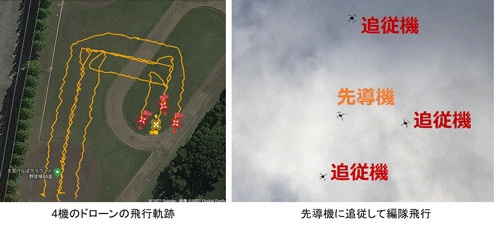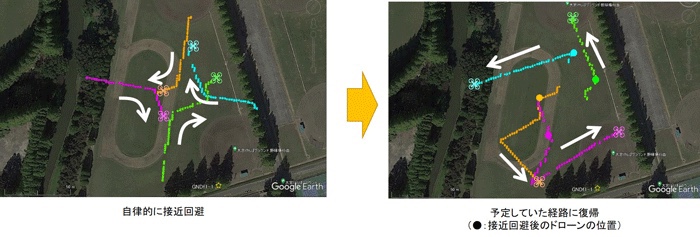

NICT: 4 drones autonomously “group flight”:
-Successful demonstration of “approach avoidance”-
National Institute of Information and Communications Technology (NICT):
April 11th,
Direct communication of four drones
For the first time in the world, we succeeded in demonstrating automatic follow-up flight and autonomous approach avoidance. It was
Direct communication system between drones:
Not via ground pilots or networks
We have developed a system in which drones communicate directly with each other, such as location information.
NICT system:
Drones hold specific low power radio stations and use radio waves in the 920MHz band.
Output is 20mW,
Available in the sky,
No radio station license required,
Broadcast communication with each other.
Mutual broadcast communication:
We have developed an “inter-airframe communication system” that shares GNSS location information.
If you connect to the flight control device of each drone, the drones can cooperate with each other.
Drone formation flight:
Three drones keep a certain interval from the leading drone.
Formation flight, while automatically following
“Group flight” to take off and land,
Autonomous “approach avoidance”,
Incorporated a flight control algorithm.
We flew in groups of four aircraft and succeeded in the approach avoidance test for the first time in the world.
Available between helicopters:
It can be used not only between drones but also between drones and manned helicopters.
A few kilometers away,
When a helicopter approaches
Drones can autonomously avoid approaching.
Simultaneous flight of multiple drones:
It can be expected to be applied to various fields such as logistics, widespread pesticide spraying, and disaster countermeasures.
Achievements this time:
More drones,
Consider communication and flight control for flying in the same airspace.
–CNET Japan
https://japan.cnet.com/article/35186147/
Direct communication between drones: automatic follow-up group flight and autonomous approach avoidance
Operate multiple drones by one person:
The need to operate multiple drones by one person is increasing.
To operate multiple drones by one person, you need wireless communication between the drone and the ground side.
Problems with radio wave complications:
However, there was a problem that the radio waves were congested.
The 2.4 GHz band used for maneuvering is commonly used.
Communication congestion can be avoided by using other frequencies (920 MHz in this case).
Use of GNSS:
There is also a “drone operation system that makes autonomous flight with GNSS location information”.
but,
“The drone autonomously follows and collaborates without going through the pilot on the ground.”
It was impossible.
Direct communication between drones:
It is important for the drone itself to know the location of the surrounding drone.
If you can avoid the collision crisis without going through the ground operator,
You can “safely use the same airspace where drones are mixed”.
2022 | NICT-National Institute of Information and Communications Technology
https://www.nict.go.jp/press/2022/04/11-1.html
NICT : 4 drones en “vol groupé” en autonomie :
-Démonstration réussie de “l’évitement d’approche”-
Institut National des Technologies de l’Information et de la Communication (NICT) :
11 avril,
Communication directe de quatre drones
Pour la première fois au monde, nous avons réussi à démontrer le vol de suivi automatique et l’évitement d’approche autonome. C’était
Système de communication directe entre drones :
Pas via des pilotes au sol ou des réseaux
Nous avons développé un système dans lequel les drones communiquent directement entre eux, comme les informations de localisation.
Système NICT :
Les drones détiennent des stations radio spécifiques à faible puissance et utilisent des ondes radio dans la bande 920 MHz.
La sortie est de 20 mW,
Disponible dans le ciel,
Aucune licence de station de radio requise,
Diffuser la communication les uns avec les autres.Communication de diffusion mutuelle :
Nous avons développé un “système de communication inter-cellule” qui partage les informations de localisation GNSS.
Si vous vous connectez au dispositif de contrôle de vol de chaque drone, les drones peuvent coopérer entre eux.
Vol en formation drone :
Trois drones gardent un certain intervalle par rapport au drone de tête.
Vol en formation, tout en suivant automatiquement
“Vol groupé” pour décoller et atterrir,
“Évitement d’approche” autonome,
Incorporé un algorithme de contrôle de vol.Nous avons volé par groupes de quatre avions et réussi le test d’évitement d’approche pour la première fois au monde.
Disponible entre les hélicoptères :
Il peut être utilisé non seulement entre drones mais aussi entre drones et hélicoptères pilotés.
A quelques kilomètres de là,
Lorsqu’un hélicoptère s’approche
Les drones peuvent éviter de s’approcher de manière autonome.Vol simultané de plusieurs drones :
On peut s’attendre à ce qu’il soit appliqué à divers domaines tels que la logistique, la pulvérisation généralisée de pesticides et les contre-mesures en cas de catastrophe.
Réalisations cette fois :
Plus de drones,
Considérez la communication et le contrôle de vol pour voler dans le même espace aérien.
–CNET Japon
Communication directe entre drones : vol de groupe suivi automatique et évitement d’approche autonome
Faire fonctionner plusieurs drones par une seule personne :
La nécessité de faire fonctionner plusieurs drones par une seule personne augmente.
Pour faire fonctionner plusieurs drones par une seule personne, vous avez besoin d’une communication sans fil entre le drone et le côté sol.
Problèmes avec les complications des ondes radio :
Cependant, il y avait un problème que les ondes radio étaient congestionnées.
La bande 2,4 GHz utilisée pour les manœuvres est couramment utilisée.
La congestion des communications peut être évitée en utilisant d’autres fréquences (920 MHz dans ce cas).
Utilisation du GNSS :
Il existe également un “système d’exploitation de drones qui effectue un vol autonome avec des informations de localisation GNSS”.
mais,
“Le drone suit et collabore de manière autonome sans passer par le pilote au sol.”
C’était impossible.
Communication directe entre drones :
Il est important que le drone lui-même connaisse l’emplacement du drone environnant.
Si vous pouvez éviter la crise de collision sans passer par l’opérateur au sol,
Vous pouvez “utiliser en toute sécurité le même espace aérien où les drones sont mélangés”.
2022 | NICT-Institut National des Technologies de l’Information et de la Communication
NICT: 4 Drohnen autonom „Gruppenflug“:
-Erfolgreiche Demonstration der “Annäherungsvermeidung”-
Nationales Institut für Informations- und Kommunikationstechnologie (NICT):
11. April,
Direkte Kommunikation von vier Drohnen
Weltweit erstmals ist es uns gelungen, einen automatischen Nachflug und eine autonome Anflugvermeidung zu demonstrieren. Es war
Direktes Kommunikationssystem zwischen Drohnen:
Nicht über Bodenpiloten oder Netzwerke
Wir haben ein System entwickelt, bei dem Drohnen direkt miteinander kommunizieren, etwa Standortinformationen.
NICT-System:
Drohnen halten spezielle Funksender mit geringer Leistung und verwenden Funkwellen im 920-MHz-Band.
Ausgang ist 20 mW,
Verfügbar im Himmel,
Keine Radiosenderlizenz erforderlich,
Broadcast-Kommunikation untereinander.Gegenseitige Broadcast-Kommunikation:
Wir haben ein „Zwischen-Flugzeug-Kommunikationssystem“ entwickelt, das GNSS-Standortinformationen teilt.
Wenn Sie sich mit dem Flugsteuerungsgerät jeder Drohne verbinden, können die Drohnen miteinander kooperieren.
Drohnen-Formationsflug:
Drei Drohnen halten einen gewissen Abstand zur führenden Drohne.
Formationsflug, dabei automatisch folgend
“Gruppenflug” zum Starten und Landen,
Autonome “Annäherungsvermeidung”,
Integriert einen Flugsteuerungsalgorithmus.Wir flogen in Gruppen von vier Flugzeugen und bestanden weltweit zum ersten Mal den Anflugvermeidungstest.
Verfügbar zwischen Hubschraubern:
Es kann nicht nur zwischen Drohnen, sondern auch zwischen Drohnen und bemannten Hubschraubern eingesetzt werden.
Ein paar Kilometer entfernt,
Wenn sich ein Helikopter nähert
Drohnen können eine Annäherung autonom vermeiden.Gleichzeitiger Flug mehrerer Drohnen:
Es ist zu erwarten, dass es in verschiedenen Bereichen wie Logistik, weit verbreitetem Versprühen von Pestiziden und Katastrophenschutzmaßnahmen angewendet wird.
Erfolge diesmal:
Mehr Drohnen,
Berücksichtigen Sie die Kommunikation und Flugsteuerung für das Fliegen im selben Luftraum.
–CNET Japan
Direkte Kommunikation zwischen Drohnen: automatischer Nachfolge-Gruppenflug und autonome Anflugvermeidung
Mehrere Drohnen von einer Person bedienen:
Die Notwendigkeit, mehrere Drohnen von einer Person zu bedienen, nimmt zu.
Um mehrere Drohnen von einer Person bedienen zu können, benötigen Sie eine drahtlose Kommunikation zwischen der Drohne und der Bodenseite.
Probleme mit Funkwellenkomplikationen:
Es gab jedoch ein Problem, dass die Funkwellen überlastet waren.
Üblicherweise wird das zum Manövrieren verwendete 2,4-GHz-Band verwendet.
Kommunikationsstaus können vermieden werden, indem andere Frequenzen (in diesem Fall 920 MHz) verwendet werden.
Verwendung von GNSS:
Es gibt auch ein “Drohnen-Betriebssystem, das autonome Flüge mit GNSS-Standortinformationen durchführt”.
sondern,
„Die Drohne folgt autonom und kooperiert, ohne den Piloten am Boden zu durchlaufen.“
Es war unmöglich.
Direkte Kommunikation zwischen Drohnen:
Für die Drohne selbst ist es wichtig, den Standort der umgebenden Drohne zu kennen.
Wenn Sie die Kollisionskrise vermeiden können, ohne den Bodenbetreiber zu durchlaufen,
Man könne „sicher denselben Luftraum nutzen, in dem Drohnen gemischt werden“.
2022 | NICT-Nationales Institut für Informations- und Kommunikationstechnologie